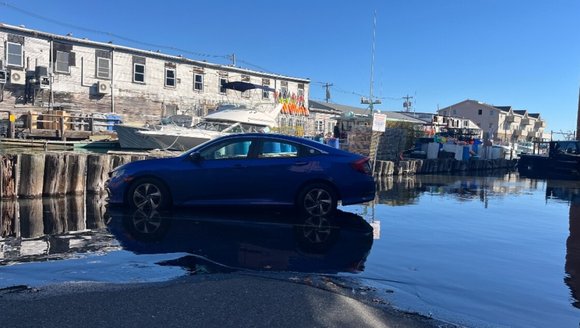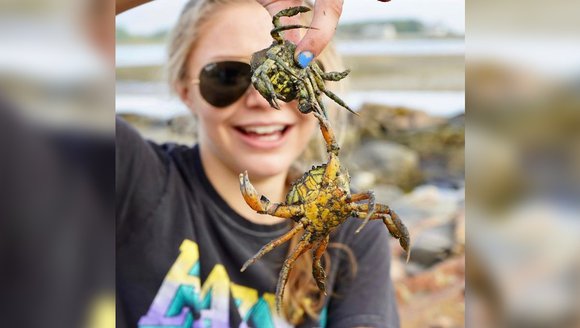Community Science 2024 Wrapped
Perspectives | Jan 10, 2025
Climate change is not selective when it comes to the locations and ecosystems it impacts — it's all around us and impacts the oceans, the forests, and everything in between. However, collecting the amount of data required to understand climate impacts everywhere is impossible for scientists alone, which is why we depend on volunteers throughout the Northeast to help us investigate their local environments.
Join us in celebrating the contributions of the community scientists, including thousands of students who supported our research in 2024.

Community Science at a Glance
Community scientists, including thousands of students, across the Northeast helped us advance work on many important projects.

Community Science Volunteers
Whether participating independently, joining us for an event, or as a student from one of 55 participating classrooms, each volunteer contributed meaningful data.

Data Points Collected
With 2,075 data points collected, volunteers provided researchers with a more robust dataset that would not otherwise be possible by scientists working individually.

Contributing Counties
In 2024, community science volunteers submitted data from 17 counties across three states. Their dedication made it possible to gather the broad range of data our projects need.

Community Science Projects
Our community science volunteers helped advance nine projects in 2024. Each of these projects help to foster climate resilient communities and ecosystems.
Hemlock Woolly Adelgid Project
The hemlock woolly adelgid (HWA) is a small insect that drains sap from hemlock branches until the tree dies. Until recently, cold winters have limited this beetle’s spread. As winter temperatures warm, scientists and resource managers suspect this pest could continue to spread throughout our region, which is why we created a community science project focused on tracking their populations. To protect the hemlock trees in the Northeast, resource managers need to know where HWA exists, so they can create effective mitigation strategies.
One way to combat these pests is to introduce populations of predator beetles that prey on them. Students from Loranger Memorial School in Old Orchard Beach, ME worked with Colleen Teerling from the Maine Department of Agriculture, Conservation, and Forestry to release these predator beetles on the trees and help eradicate the population of HWA.

"Last year, we found HWA on ten trees in our forest. Then Colleen Teerling taught us that we could defend our Hemlock trees from HWA by releasing predator beetles that eat the invasive bugs. We asked Old Orchard Beach Conservation Commission for $500 so we could purchase 250 beetles." — Student Scientist, Loranger Memorial School, Old Orchard Beach, ME
Pictured: Colleen Teerling (Maine DACF) and students from Loranger Middle School releasing predator beetles.
This is a prime example of community science efforts and student scientists leading to real-world solutions to climate issues.
Of all our community science projects, the HWA effort saw the highest level of classroom participation. This is a prime example of community and student science efforts leading to real-world solutions to climate issues. Involving students in community science projects like this improves their climate literacy and familiarizes them with conservation. We are proud to create experiences for students that will help grow the next climate-conscious generation.
Intertidal Crab Project
The intertidal crab project focuses on monitoring populations of invasive crab species like Asian shore and European green crabs in the Gulf of Maine’s intertidal ecosystems.
As the Gulf of Maine's waters warm, researchers are working to understand how invasive crab populations are changing in our region. Invasive crabs destroy eelgrass habitats and prey on small shellfish, which effects the long-term health of our intertidal ecosystems.
The Gulf of Maine has an expansive coastline — too much ground to cover for researchers alone when it comes to collecting data on crab populations. However, in 2024, community science volunteers submitted 1,330 data points to the intertidal crab project. As Dr. Marissa McMahan, the lead scientist on the project can attest, this vast amount of community scientist contributed data helps her keep track of population trends over time.
This year we have found a lower abundance of green crabs at many of our sites, and we’re not entirely sure why that might be. This is why it’s so important to look at the big picture to understand trends over time and in different areas — which is exactly what you all are contributing to!
Marissa McMahan, Ph.D. Director of Fisheries Manomet


Trends become clearer as more data becomes available over longer periods of time. That’s why we still need the help of community scientists up and down the coast in 2025 and beyond for our intertidal crab community science project.
Protecting Ash for the Future
Brown ash trees are critical to forest ecosystem health and to the cultural lifeways of Wabanaki people who have been stewarding this species for thousands of years. Wabanaki basketmakers depend on brown ash tree populations to make their baskets, but climate change and the spread of the emerald ash borer into the Northeast are threatening the health of these trees with the potential to eliminate ash from our region if we do not act quickly.
To help researchers and conservationists gain a better understanding of what’s happening to brown ash trees in the Northeast, community members and students participating in Protecting Ash for the Future: A Preservation Focused Inventory Project are observing ash trees in their community and privately submitting data to state resource managers and Tribal Nations. This hands-on effort promotes ecosystem stewardship and supports the Wabanaki people in protecting a species that is central to their cultural identity.
You can help us by collecting data about the ecosystem qualities around Maine that have brown ash and if you find places that may have trees that are good for basket making, we can share that with Tribal Nations and Tribal Nation basketmakers to potentially connect with landowners in the future and make art out of the tree they harvest.
Ella McDonald Project Team Leader for Ash Protection Project
Not only are Maine’s brown ash trees a vital part of Wabanaki culture, their protection is also a priority to preserve biodiversity in eastern North America.
Ash is not just important for Maine, it is important for all of eastern North America, because we have one of the last areas of good healthy ash left.
Colleen Teerling Maine Forest Service
This project demonstrates how community science volunteers can help preserve both biodiversity and cultural traditions by contributing to our projects.


Coastal Flooding Project
The Coastal Flooding Community Science project offers an opportunity for communities to document impacts of coastal flooding to better understand what water levels and weather conditions lead to coastal flooding near them.
In January of 2024, Maine experienced historic levels of coastal flooding. Many communities, their residents, and places they hold close were impacted. Observing high water events can be emotional, as it can expose the vulnerabilities of communities in the face of climate change. One student in Machias recalls the impact that witnessing flooding in their community had on them:
It was a very interesting and at times conflicting feeling seeing the effects of climate change so up close. It was really exciting on one hand, being able to do some real groundwork research and feel like a part of the solution, but at the same time a pit of fear sometimes would sit in my stomach when I realized what I was looking at. The marvel of nature is beautiful and dangerous in a way which kind of mirrors the astronomical extremes of the universe. A sobering realization of both the fragility of life and the interconnected chaos of the universe. I couldn't help but feel grateful in a way. A really awesome and grounding experience!
Student Scientist Washington Academy, Machias, ME
Through the coastal flooding community science project, we not only collect important information that helps us develop and deliver localized adaptation and resilience strategies for towns throughout Maine, but we also see an increase in personal connections to the places people call home.


How You Can Make a Difference
Addressing the challenges related to climate change can be overwhelming for individuals. It might seem like there isn’t anything you can do alone to make a difference, but that’s just not true. Each data point above was contributed by an individual, and those data points have generated real-world solutions to climate-related challenges.
Community science efforts in 2024 brought community scientists into the field, where they actively engaged with the world around them to collect data on climate-related challenges that are both local and meaningful. These experiences not only inspire and empower people to make a difference but also connect their efforts to the broader scientific community. The data they gather contributes to ongoing research projects led by professional scientists, providing critical insights that inform real-world solutions. In many cases, these projects lead to tangible actions addressing pressing environmental issues, showcasing the transformative power of community-driven science.
The projects listed above represent just some of the many community science projects you can contribute to in 2025. Explore the full list of community science projects you can contribute to here. Thank you to all who contributed in 2024, and we look forward to another year of community-driven climate action!
Interested in participating in a community science project?
Check out the Ecosystem Investigation Network for current projects, resources, and upcoming events.



